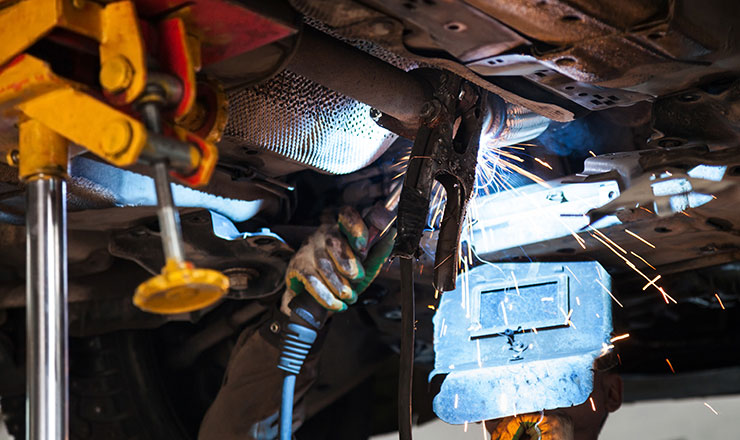Why Does Auditing Fixed Assets Matter for Lifecycle Management?

Take Control of Your Assets
A personalized demo is just one click away.
Did you know your organization’s fixed assets each have a lifecycle? The fixed asset lifecycle begins with the organization’s initial capital investment into the asset and concludes when the asset is retired or replaced. Paying careful attention to this timeline using a process called fixed asset lifecycle management is crucial for businesses to ensure asset longevity, compliance, and cost-effectiveness.
Fixed asset lifecycle management consists of a range of strategies that allow an organization to keep an eye on each asset’s upfront cost, current depreciation, and likely date of replacement, the better to maximize the organization’s return on investment for each asset. From equipment to vehicles to software, all fixed assets have a different lifecycle depending on their type, but there’s one strategy all organizations ought to enact no matter what kind of fixed assets they rely on. That strategy is the internal asset audit, a company-wide assessment of the overall health of its fixed assets.
In this article, we will conduct an overview of fixed asset lifecycle management and explain why all organizations that rely on fixed assets should conduct regular asset audits.
The 5 Stages of a Fixed Asset’s Lifecycle
By definition, a fixed asset must have a useful life that extends longer than one accounting period, which is typically one fiscal year. That means fixed asset management is a process that occurs over multiple years. Whether a fixed asset is tangible, like a building or a computer, or intangible, like a piece of software, it has an expected number of years in its useful life. For example, the typical useful life of a computer is 5 years.
While useful life is essential for accounting and depreciation purposes, it is only one portion of a fixed asset’s lifecycle. In reality, the fixed asset lifecycle consists of five main stages. Here are the five stages of the fixed asset lifecycle and some questions to consider in each of these phases.
- Planning. What does the data say about why a new asset is needed? What value will this asset add to the business?
- Acquisition. Where and how was the asset acquired? What was the upfront cost?
- Utilization. How far is this asset into its useful life? Is it being underutilized and should it be re-allocated? As the fixed asset ages, what is its decline in value? Which method do you use to calculate the asset’s accumulated depreciation?
- Maintenance. As the fixed asset ages, what repairs, renovations, or updates does it require, and on what schedule? How much time and resources will this maintenance require?
- Disposal. When the fixed asset is retired, is it sold off or recycled? What costs and regulatory requirements go along with asset disposal, particularly large equipment or IT assets? Is the asset archived in the system? Finally, what is the plan to replace this asset?
What is Fixed Asset Lifecycle Management?
No matter the industry or company size, organizations everywhere rely on fixed assets to help them generate income. These organizations can save money and increase productivity when they develop a plan to extend the useful life of each fixed asset through fixed asset lifecycle management.
Fixed asset lifecycle management provides a framework for monitoring assets as they undergo each of the five stages of the fixed asset lifecycle. It encapsulates the full end-to-end collection of strategies that an organization uses in each stage of an item’s useful life.
Here is an example of a fixed asset lifecycle management framework:
- During the planning stage, an organization must determine the necessity of the new asset along with their budget. They should then define the minimum usage or units of production this item should output to provide a return on the company’s investment.
- In the acquisition stage, the organization should have standardized processes for procuring new assets and adding them to their fixed asset management system for future tracking purposes.
- In the utilization stage, there should be a consistent strategy for deploying fixed assets and training employees on how to use them. There should also be regular assessments of the asset’s usage to date to ensure proper allocation and planning for maintenance or replacement.
- In the maintenance stage, an organization should decide whether to conduct repairs at regular intervals or on an as-needed basis. Each accounting period, the organization should also calculate and record the fixed asset’s depreciation.
- Finally, in the disposal stage, there ought to be decided-upon methods of archiving an asset in the system and selling it off or disposing of it. This stage will likely consist of varying methods, as fixed assets like IT equipment are subject to environmental regulations upon disposal. The organization should also have a uniform strategy and timeline for replacing the retired asset with a new one.
Lifecycle management will be unique to each organization based on the type of fixed assets they utilize and the items’ specific attributes. No matter the size or breadth of a company’s inventory, all businesses should conduct regular fixed asset audits.
How to Audit Fixed Assets With Lifecycle Management In Mind
Routine audits of an organization’s fixed assets play an important role in lifecycle management. In order to conduct one, a company should maintain a comprehensive database of all of its fixed assets and check regularly if the assets themselves accurately measure up to what is recorded.
This database should store detailed information about each fixed asset, including the item’s unique ID, acquisition date, expected useful life, purchase cost, accumulated depreciation, and current location or assignee. With comprehensive asset records in one unified system, employees can easily conduct inventory audits to confirm if the stored information is still correct or if there are any discrepancies. Routine fixed asset inventory audits (e.g., quarterly or annually) allow organizations to maintain accurate records as they consistently confirm that their assets are in the places and conditions they’re expected to be.
While a fixed asset audit can seem daunting, the right tools and strategies can make audits easy and repeatable. If all fixed asset data is kept in an Excel spreadsheet and only one or two members of the organization maintain and update it, a fixed asset audit will be a very big job for them to undertake. On the other hand, if the data is kept in a secure, custom central hub that can grant access to many different employees based on the fixed assets they work with most regularly, then your organization can use a divide-and-conquer strategy to accomplish audits quickly and effortlessly.
Managing Fixed Assets and Audits with Asset Panda
No matter what type of assets your organization needs to track, a proper asset management and audit solution is essential to effective fixed asset lifecycle management. With a cloud-based solution like Asset Panda, you can finally unify your fixed asset data to save time and resources and eliminate surprise costs or replacements.
Asset Panda’s cloud-based solution can be customized to meet your organization’s unique needs. Asset Panda’s robust fixed asset management solution not only maintains full lifecycle records but allows you to build customized audit checklists and assign them to the right employees. This way, you can easily split the workload across departments or locations, making asset audits achievable and repeatable. Plus, Asset Panda offers a convenient mobile app with built-in barcode technology, allowing you to quickly audit items with a single scan.
With Asset Panda’s powerful mobile audit tool, your workplace can efficiently conduct audits using the smartphones that you and your employees already have. Discover what Asset Panda can do for you and request your personalized demo today.
Take Control of Your Assets
A personalized demo is just one click away.
Related News & Press

Learn more from an Asset Panda expert
Get a FREE consultation with an asset tracking expert to find out how you can transform your asset tracking.
Contact our Sales Team at (888) 928-6112


